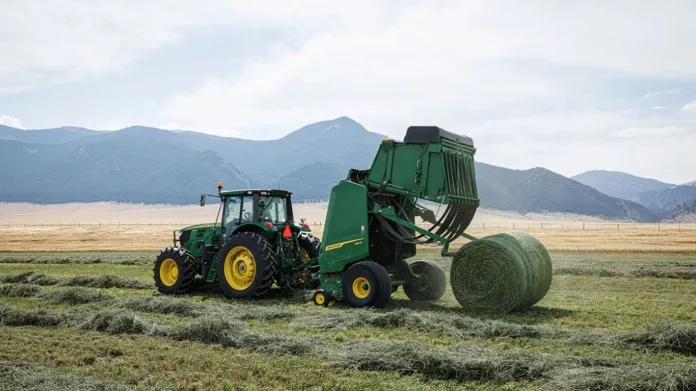Smart farming continues to evolve, bringing new efficiencies to agriculture. John Deere, a leader in advanced farm equipment, has introduced weave automation for select round balers. This innovation simplifies the baling process while improving bale quality and efficiency. In this article, we explore how this feature transforms hay and forage production.
Overview of Weave Automation
Traditionally, baling required operators to manually weave the tractor to ensure uniform bale shape. This process demanded precision and constant attention. Previous technologies, such as gate and speed automation, helped by stopping the tractor once a bale was complete. However, these systems still required manual alignment.
John Deere’s weave automation eliminates this challenge. Operators place the windrow between the tractor’s front tires, and the baler aligns automatically. This seamless process ensures consistent, high-quality bales, even for less experienced users.
How Weave Automation Works
Advanced Sensor Integration
John Deere’s system uses sensors and control algorithms to monitor and adjust baling in real time. Once the windrow is positioned correctly, the system activates. On-board sensors analyze the windrow’s position and shape to optimize baling efficiency.
Dynamic Weaving Hitch System
The dynamic weaving hitch system allows the baler to swing up to 38° left or right. This flexibility helps cover windrows of various sizes while minimizing debris contamination. The system ensures each bale maintains optimal density and structure.
Real-Time Synchronization
The baler adjusts its movements automatically to match the tractor’s speed and direction. This real-time synchronization improves bale uniformity and eliminates frequent manual adjustments.
Expert Insights
According to Kaylene Ballesteros, John Deere’s go-to-market manager for hay and forage equipment:
“Operators no longer need to weave the tractor manually to maintain bale shape. Weave automation allows seamless alignment with the tractor, improving consistency across different windrow sizes.”
Ballesteros emphasizes that the system reduces the frustration of manual adjustments and ensures consistent bale quality, regardless of experience level.
Key Benefits for Farmers
- Improved Bale Quality: Precise adjustments create well-formed, compact bales. This reduces material loss and enhances overall forage quality.
- Greater Efficiency: By automating the weaving process, the system speeds up baling. Farmers can cover more acres in less time, which is essential during peak harvest periods.
- Reduced Operator Fatigue: Less manual input means operators experience less strain. They can focus on other farm tasks while achieving superior baling results.
- Enhanced Safety: The system adapts to uneven terrain, lowering the risk of operator errors and equipment damage.
- Increased Versatility: Weave automation allows balers to handle windrows of different shapes and sizes, making John Deere’s round balers more adaptable to various farming needs.
Conclusion
John Deere’s introduction of weave automation marks a significant leap forward in agricultural machinery technology. By automating the intricate weaving process during baling, this innovation not only enhances bale quality and production efficiency but also improves safety and ease of operation. For farmers striving to maximize yield and reduce labor-intensive tasks, this technology is set to be a game-changer.
To learn more about John Deere’s Weaving Automation Technology, please watch the following video:

